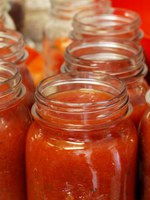Preserve Your Garden’s Bounty Safely With Free Resources
(Click the image below to view a high-resolution image that can be downloaded)
If your garden is producing a bountiful crop of vegetables, you may be thinking about canning some to eat later, such as this winter.
You‘ve probably found lots of recipes on the internet and in old cookbooks, and friends and family have offered you tons of advice on how to preserve those vegetables.
“Most of those recipes haven’t been tested for safety,” says Julie Garden-Robinson, food and nutrition specialist for the North Dakota State University Extension Service. Extension provides free information on food preservation.
Food preservation guidelines have changed through the years as scientists learn what is and isn’t safe. Plus, the vegetable varieties available today are not the same as those grown when your great-grandmother was canning. For example, tomato varieties have been bred to be less acidic to appeal to our modern tastes. So great-grandma’s famous canned tomato recipe could have dire results when using current tomato varieties.
“The acidity of a food determines how it should be canned,” Garden-Robinson says. “Low-acid foods such as meat, poultry, seafood, soups, vegetables (except those that have been acidified) and mixtures of acidic and low-acid foods must be processed in a pressure canner.”
Improper canning can lead to the development of deadly bacteria and toxins. This is why using up-to-date equipment and research-tested methods when preserving food is vital, according to Garden-Robinson. That means canning in an oven or microwave is not safe.
What if you invent your own salsa recipe? Freezing it is the best way to preserve salsa made from a recipe that hasn’t been research-tested. If you are using a research-based recipe, follow it carefully. Substituting ingredients and changing proportions can be a recipe for disaster.
“Remember this: When you preserve food at home, especially by canning, you are a scientist,” Garden-Robinson cautions. “Food preservation isn’t the time to put on your ‘creative’ hat.”
Selecting the right container for preserving your garden’s bounty is just as important.
“Mason-type jars are the best choice for canning,” Garden-Robinson says. “Some people like to re-use glass mayonnaise or salad dressing jars. The National Center for Home Food Preservation says that is OK if new two-piece lids are used. However, they have a narrower sealing surface and are tempered less than Mason jars, so expect more seal failures and breakage when reusing jars that once held commercial products. Don’t process mayo jars in a pressure canner, though.”
To seal jars, use self-sealing lids that consist of a flat lid and a screw band. Tighten the screw band with your fingers, not your muscles, because overtightening can lead to seal failures. You can reuse screw bands, but don’t reuse lids.
When freezing vegetables, use plastic freezer containers, glass canning or freezing jars, or plastic bags designed for freezer storage. Using plastic containers that previously held products such as margarine or whipped topping can result in the food developing freezer burn or dehydrating.
“Freezer burn is a quality issue, not a safety issue, but you may not want to eat freezer-burned food because of the changes in the color, texture and flavor,” Garden-Robinson says.
Most vegetables should be blanched for a specific amount of time before being frozen. Blanching is scalding vegetables in steam or boiling water for a short time. That keeps the vegetables from discoloring, toughening or developing off-colors or off-flavors during frozen storage.
In addition to using research-tested recipes, be sure you have all the equipment and supplies you need, Garden-Robinson advises. Some county offices of the NDSU Extension Service have pressure gauge testers.
Visit the NDSU Extension Service’s website at https://www.ag.ndsu.edu/food/food-preservation for free information and some tasty, research-tested recipes. Click on the category on the left side (computer/tablet) or in the top drop-down menu (smartphone) for your topic of interest.
You also can contact your local office of the NDSU Extension Service for more information.
| Source: | Julie Garden-Robinson, 701-231-7187, julie.garden-robinson@ndsu.edu |
|---|---|
| Editor: | Ellen Crawford, 701-231-5391, ellen.crawford@ndsu.edu |


